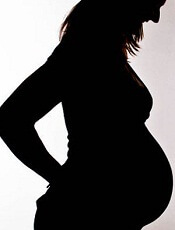
Photo by Nina Matthews
Research has shown that women have an increased risk of venous thromboembolism (VTE) after giving birth, but it’s believed that a cesarean section (CS) leaves a woman more vulnerable to VTE than a vaginal delivery (VD).
A meta-analysis published in CHEST supports this idea. The data showed that CS carried a greater risk of VTE than VD, and emergency CS was associated with a greater risk than elective CS.
“We found that CS is an important, independent risk factor for the development of VTE in the postpartum period and that approximately 3 VTE will occur for every 1000 CS performed, with greater risks for nonscheduled, emergency CS,” said study investigator Marc Blondon, MD, of Geneva University Hospitals in Geneva, Switzerland.
Analysis results
Dr Blondon and his colleagues evaluated 28 studies (most of them retrospective) comparing the risk of VTE after CS and VD (>53,000 VTEs) and 32 prospective studies reporting the risk of VTE after CS (218 VTEs).
In unadjusted analyses of the individual studies, the risk of VTE was 1 to 22 times higher after CS than after VD. The pooled random effect odds ratio (OR) was 3.7 (95% CI, 3.0-4.6).
The investigators said adjusting analyses for at least maternal age had a marginal effect in the 7 studies that included both univariate and multivariate analyses. The OR comparing CS with VD was 3.3 (95% CI, 2.5-4.5) in univariate analyses and 2.8 (95% CI, 2.1-3.8) in adjusted analyses.
Similarly, adjusting analyses for both maternal age and body mass index had a slight effect in the 4 studies in which researchers adjusted for at least these 2 factors. The pooled OR was 2.8 (95% CI, 2.1-3.7) in crude analyses and 2.5 (95% CI, 1.8-3.1) in adjusted analyses.
When the investigators combined all 7 studies reporting adjusted risk estimates, the OR was 2.7 (95% CI, 2.2-3.3).
The data also showed an increased risk of VTE for both elective and emergency CS when compared to VD. The pooled ORs were 2.3 (95% CI, 1.7-3.1) for elective CS and 3.6 (95% CI, 2.8-4.7) for emergency CS.
After adjustment (in 6 studies), the pooled ORs were 2.1 for elective CS and 2.8 for emergency CS.
Explanations and implications
The investigators noted that pregnant women become more susceptible to VTE due to a variety of factors, including venous stasis and trauma associated with delivery. In addition, hemostatic changes drive increases in some coagulation factors while decreasing bleeding inhibitors.
For some reason, these changes seem to be worse for women who deliver via CS.
“In the postpartum period specifically, women following CS exhibit greater activation of coagulation than women following VD, as reflected by greater D-dimer levels,” Dr Blondon explained.
“This outcome may be a result of the conditions leading to the CS or to the procedure itself, similar to the increased VTE risk following non-obstetric surgery. Furthermore, physical activity is reduced following CS compared with following VD, with delayed recovery of mobility occurring in the first 2 days following delivery.”
Dr Blondon and his colleagues said this study helps shed some light on VTE risks associated with CS. Practitioners should be aware of the risks, and further research is needed to plot the best course of action and inform future guidelines concerning thromboprophylaxis.
“Thromboprophylaxis [after CS] seems widely underutilized in the United States,” Dr Blondon said. “It is estimated that 75% of women following CS do not receive any prophylaxis in the postpartum period. This scenario may arise from a lack of recognition by care providers of the risk of VTE following CS.”
“Preventing postpartum VTE following CS may lead to an important reduction of its associated morbidity and mortality from a public health perspective. In this setting, further observational studies and randomized trials are needed to better appreciate the risks of VTE in specific groups following CS and to define the efficacy and safety of thromboprophylaxis.”


